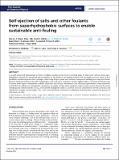| dc.contributor.author | McBride, Samantha A. | |
| dc.contributor.author | Lake, John R. | |
| dc.contributor.author | Varanasi, Kripa K. | |
| dc.date.accessioned | 2024-05-10T20:48:38Z | |
| dc.date.available | 2024-05-10T20:48:38Z | |
| dc.date.issued | 2023-04-07 | |
| dc.identifier.issn | 0021-9606 | |
| dc.identifier.issn | 1089-7690 | |
| dc.identifier.uri | https://hdl.handle.net/1721.1/154923 | |
| dc.description.abstract | A recently discovered phenomenon in which crystalline structures grown from evaporating drops of saline water self-eject from superhydrophobic materials has introduced new possibilities for the design of anti-fouling materials and sustainable processes. Some of these possibilities include evaporative heat exchange systems using drops of saline water and new strategies for handling/processing waste brines. However, the practical limits of this effect using realistic, non-ideal source waters have yet to be explored. Here, we explore how the presence of various model aquatic contaminants (colloids, surfactants, and calcium salt) influences the self-ejection phenomena. Counterintuitively, we find that the addition of “contaminant” chemistries can enable ejection under conditions where ejection was not observed for waters containing only sodium chloride salt (e.g., from smooth hydrophobic surfaces), and that increased concentrations of both surfactants and colloids lead to longer ejection lengths. This result can be attributed to decreased crystallization nucleation time caused by the presence of other species in water. | en_US |
| dc.language.iso | en | |
| dc.publisher | AIP Publishing | en_US |
| dc.relation.isversionof | 10.1063/5.0142428 | en_US |
| dc.rights | Creative Commons Attribution | en_US |
| dc.rights.uri | https://creativecommons.org/licenses/by/4.0/ | en_US |
| dc.source | AIP Publishing | en_US |
| dc.title | Self-ejection of salts and other foulants from superhydrophobic surfaces to enable sustainable anti-fouling | en_US |
| dc.type | Article | en_US |
| dc.identifier.citation | Samantha A. McBride, John R. Lake, Kripa K. Varanasi; Self-ejection of salts and other foulants from superhydrophobic surfaces to enable sustainable anti-fouling. J. Chem. Phys. 7 April 2023; 158 (13): 134721. | en_US |
| dc.contributor.department | Massachusetts Institute of Technology. Department of Mechanical Engineering | |
| dc.relation.journal | The Journal of Chemical Physics | en_US |
| dc.eprint.version | Final published version | en_US |
| dc.type.uri | http://purl.org/eprint/type/JournalArticle | en_US |
| eprint.status | http://purl.org/eprint/status/PeerReviewed | en_US |
| dc.date.updated | 2024-05-10T20:44:45Z | |
| dspace.orderedauthors | McBride, SA; Lake, JR; Varanasi, KK | en_US |
| dspace.date.submission | 2024-05-10T20:44:48Z | |
| mit.journal.volume | 158 | en_US |
| mit.journal.issue | 13 | en_US |
| mit.license | PUBLISHER_CC | |
| mit.metadata.status | Authority Work and Publication Information Needed | en_US |
